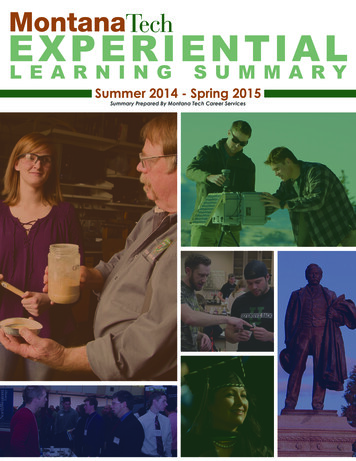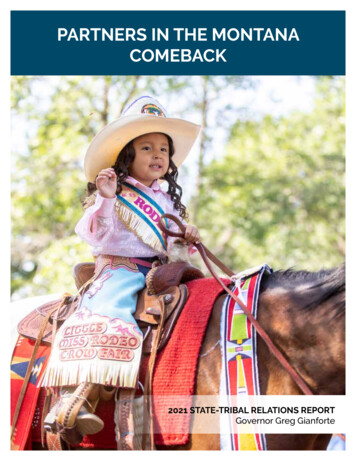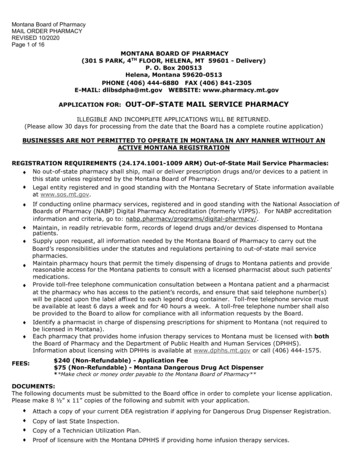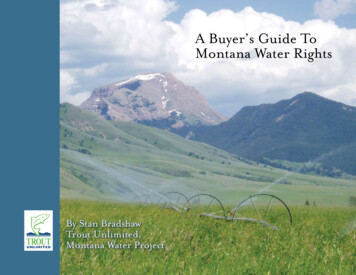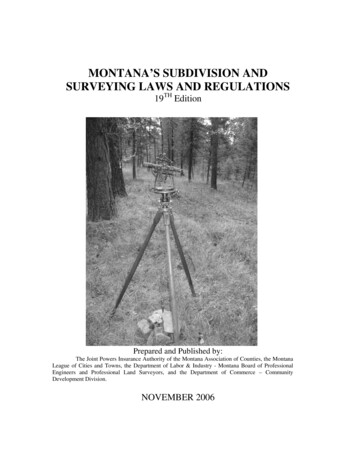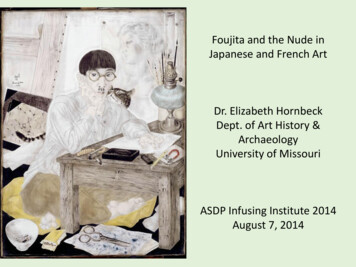
Transcription
FIGURE 5.1: Fort Union on the Missouri, by Karl Bodmer, ca. 18451670sHudson’s BayCompany entersNorth Americanfur trade1720–60Horses andguns poxepidemics killmany MontanaIndians1776United StatesdeclaresIndependencefrom Great Britain1775–17901804–6Lewis and ClarkExpedition18001807Americans establishthe first fur tradingpost in Montana1808American FurCompany formed1830sMontana fur tradersturn to bison hunting18201825First fur trade rendezvous18281809Fort Union establishedSt. Louis MissouriFur Company formed
READ TO FIND OUT: How beaver changed the history of this region How Indian people helped the fur trade Why the market shifted from beaver to bison Who the “Black Robes” were and how theyinfluenced Indian lifeThe Big PictureThe fur trade was the beginning of a new economybased on exploiting natural resources mostly for theprofit of people living far away.Second to humans, beavers change the landscape more than anyother animal. They dam streams, create wetlands, and trim trees. Theyalso create habitat for fish, turtles, frogs, and ducks.In the early 1800s beavers changed the history of Montana, too.When Lewis and Clark floated downriver toward St. Louis in 1806,they met eleven separate trapping parties heading up the MissouriRiver. Already, adventurers and fur traders were excited about making money in this region. By this time the fur trade was well establishedin North America, and eastern Indian tribes had been involved formore than 100 years.The fur trade followed the Lewis and Clark Expedition into presentday Montana. It changed people’s economic activities and their travelpatterns. It brought the first wave of outsiders drawn here by thenatural resources of the land. It created new conflicts between tribes.And when the beaver trade shifted to the bison robe trade, it nearlydestroyed the bison species altogether.1846Fort Benton fur tradingpost established1860First steamboatarrives inFort Benton1848California gold rush18401837–40Smallpox epidemics killmany Montana Indians1832The steamboat Yellowstonereaches Fort Union1876Battle of theLittle Bighorn1862Montana goldrush begins18601841Father DeSmet buildsSt. Mary’s Mission1880First train entersMontana Territory18801874Samuel Walking Coyotebrings bison to theFlathead Reservation1883Fewer than 200bison remain onthe Plains19001883–84Many members of the northerntribes die during Starvation Winter4 — NEWCOMERS EXPLORE THE REGION8181
Mil kKootenaiPost, 1808RiCl aRockor kkFuntaJuneaux Post, 1872(Fort Turnay)Hammel’sHouseFort McKenzie,1833–44Fort Browning,1869–71MiYelerRivBi tte r r o ot Rur ii v erssoFort Owen,1850–72Fort Sarpy,1857–c. 1860Robert’s Trading Post, 1871Fort Pease, 1875–76Fort Cass, 1832–35Three Forks Post(Fort Henry), 1810erYellowstone Riv4060ounttM2080100a i nsFIGURE 5.2Montana Joinsthe World Marketan, trappers wereIndian or non-Indioney. Usually theyseldom paid in mls and supplies towere paid in materiawinter.last them anotherof beaver, otter,What they sold: furs;elk, deer, and bearand mink; skins ofw.s, and tallobison robes, tongue: red, blue, andWhat they boughtbeads, wide leathergreen cloth, glassankets of variousbelts, clothing, blles, tin kettles, copkinds, Spanish saddles, axes, hatchets,per pots, fancy bridtraps, guns, ammuknives, rope, files,cco, coffee, flour,nition, sugar, tobaand liquor.82Fort Van Buren, 1832–43 (Fort Cass)Fort Benton, 1821–23(Yellowstone)Fort Manuel Lisa,1807–11rooMiles0Fort Alexander,Fort Sarpy,1842–501850–55B i t t er to neRiverontFort Connah, 1847–71in FrFlathead Post, 1823(Saleesh House)y MoSaleesh (Salish) House1809–47Price’s Post,1870Fort Jackson, Fort Stewart,Tom Campbell’sFort Copeland,House, 1870–711865–67 Wolf Point 18331854–63Fort Union,Baker’s Post,Post,1860sFort Kaiser, c. 1865–671828–651868–69Fort Kipp,PoplarPost1859–60Fort La Barge, 1862–63Fort Andrew(s), Fort Galpin, 1862–84Fort Chardon,Fort William,1860–801862–661844–45Fort Peck, 1866–79Fort Gilbert,1833–58Fort Charles,Fort Piegan,Fort Dauphin, 1861–62Rocky Point,1864–67Fort Porchette, 1871Fort Benton, 1846–831831–321860–671881–82(Fort Lewis, Fort Clay)Fort Campbell,Brasseau’s House,1846–60 Fort Clagett (Camp Cook),c. 18641866–78Fort Musselshell,Fort Lewis, 1844–47Fort Hawley,1869–74(Fort Cotton)1866–69Fort Carroll,Reed’s Fort 1874–?c. 1874sFort Sherman, 1873–74Juneau’s Fort, 1880lowBadger Creek Post, 1868Howse’s House, 1810–11rv erFort Conrad, 1875–87Fort Kootenai, 1811Fort Belknap,1871–73Fur Forts in MontanaAt the Center of the Storm:North American BeaverEuropean people’s demand for beaver fur began even before they setfoot on North America. The beaver’s durable, warm, elegant fur made theperfect top hat. Beaver hats, coats, and other fur items became very fashionable among high-class Europeans. But by the 1700s most of Europe’sbeavers were killed off. As demand for beaver increased, fur companiessent explorers out across Canada and North America to find more.When explorers arrived in the Rocky Mountain region, they foundthat beavers were more abundant here than elsewhere. The fur fromRocky Mountain beaver was also thicker and more luxurious. Soonbeaver pelts were so valuable that they became their own currency inthe Rocky Mountain region. They were not only worth dollars, butthey also could be exchanged as dollars.British Companies in Western MontanaTwo main British-owned fur companies competed for North America’sfurs: the Hudson’s Bay Company and the North West Company. TheHudson’s Bay Company was the first corporation in North America.It started the North American fur trade in 1670 in northern Canada.The Hudson’s Bay Company and the North West Company werebitter rivals for the profits of North American beaver. Whereverthe North West Company built a trading fort, the Hudson’s BayCompany would follow behind to build one, too.PART 2: A CENTURY OF TRANSFORMATION
FIGURE 5.3FIGURE 5.4But the high cost of competition—and a slump in the European furmarket—ate up profits for both companies. After years of bitter rivalry,the two companies merged in 1821 into one business named the Hudson’sBay Company.The two British companies operated mostly to the north and west ofpresent-day Montana. They built forts in northwest Montana, west ofthe Continental Divide.Fur companies often sent brigades (teams) of Indian, Métis, andnon-Indian trappers out of fur posts on long expeditions. This practicebecame known as the post-and-brigade system. The brigades commonlywent out for a year at a time. They traveled through a specific region,camped together, often split up to cover more ground, and watched outfor one another’s safety as they trapped an area and moved on.The fur trade could not have happened without the AmericanIndians. Assiniboine and Cree bands, who dominated present-daycentral Canada, were accomplished middlemen between fur traders andother tribes. They transported beaver pelts and bison robes to tradingforts, where they exchanged them for manufactured goods. Then theytraded those goods with other Indian groups for more pelts and robes.Many tribes across the continent provided furs in trade, allowedfur companies to build forts, and helped the trappers and traders. Theytraded furs and hides for European items like guns, metal arrowheads,scissors, and iron pots that made their lives easier or gave them anadvantage over other tribes.FIGURE 5.5FIGURES 5.3, 5.4, and 5.5: How did a beaver’sfur become a hat? Trappers stretched andflattened hides into plews (figure 5.4) tomake them easier to transport. Each plewweighed at least 1½ pounds and wasworth about 6 ( 135 today). Transformingplews into top hats (figure 5.5) took timeand skill. Europeans wore beaver felt hatsfor 300 years (1550 to 1850).Bridge Between Cultures: The Métis in the Fur TradeFrom the eastern Great Lakes region to the Rocky Mountains, the fur traderelied on the Métis people. The Métis were the mixed-blood descendants ofearly European fur traders who married native women. The French calledthem “métis,” meaning “mixed.” Over time they developed their own language and a separate identity as a people. They called themselves Métis.Born into the fur trade, the Métis acted as a bridge between Indian andnon-Indian cultures. They spoke both native and European languagesand had family ties to both groups. By the middle of the 1700s, they hadbecome as necessary a part of the fur trade as the beavers themselves.5 — BEAVER, BISON , AND BL AC K ROBES83
Many cities in the Great Lakes area, including Chicago, Detroit, GrandRapids, and Milwaukee, began as mixed-blood communities in the early1700s. By 1815 Métis settlements spread from present-day Detroit,Michigan, to Winnipeg, Manitoba (Canada). Many of Montana’sMétis people trace their heritage back to these communities.As the fur trade pressed westward, the mixed-descent peopleImage removed due to copyrightmoved with it. They supplied furs, bison robes, and pemmirestrictions. To view the image, seecan (a traditional Northern Plains food made of dried meat,the print edition offat, and berries) to trading forts from the lower MissouriMontana: Stories of the Land.River region north to central Canada. Many military fortsand trading posts increasingly depended on the Métis.The Métis delivered hundreds of thousands of poundsof supplies per year using Red River carts. These twowheeled carts were made entirely of wood lashed togetherwith bison hide and sinew (animal tendon). The axle wasusually an unpeeled log. They did not grease the axle because inthat dusty environment grease would attract enough grit to grind theaxle off in a day’s travel. As the ungreased wheels turned against the axle,FIGURE 5.6: Alexander Ross led one of thebiggest Nor’Wester brigades in 1823. Hethey made a terrific screeching noise that echoed across the grasslandsand 55 Indian and white trappers, withformiles.89 women and children, traveled fromSpokane House (near present-day Spokane,Washington) throughout western Montana,arriving at Saleesh House with 5,000beaver pelts.Americans Join the Race for FursPicture the British companies circling overland around Montana fromthe north and west, and American fur companies spreading up theMissouri River from the southeast. In 1807 Manuel Lisa, a SpanishAmerican born in Cuba, built the first fur post in present-day Montana.Fort Manuel Lisa, also called Fort Ramon, stood at the confluence of theYellowstone and Bighorn Rivers.In 1809 Lisa and several partners formed the St. Louis Missouri FurCompany, the first American-owned fur company to operate in the region. It enjoyed a successful first year, operating mostly in Crow country.But the next year was a lot tougher.In 1810 a group of 34 trappers left Fort Ramon for the Three Forksto build a trading post. They knew that a post at the Three Forks wouldgive them access to the many tribes who used that area at different times.However, the Blackfeet fiercely protected this important area. They didnot want the Americans supplying guns to enemies of the Blackfeet.The Blackfeet soon surrounded the Missouri Fur Company post andbegan a series of attacks. The siege lasted for months and killed 20 furmen. The rest abandoned the fort.FIGURE 5.7: Métis men often wore capotes—coats madefrom thick, wool Hudson’s Bay blankets and tied with acolorful handwoven sash. They wore colorful leggings,and their moccasins often were beaded with elegant designs.84PART 2: A CENTURY OF TRANSFORMATION
Manuel Lisa discovered that it was impossible to maintain and defendtrading forts through the winter in places where the Indian tribes did notwant them to be. Then he lost 20,000 worth of furs and robes (worth 338,000 today) in a fire. Soon the Missouri Fur Company was drivenback downriver. It had lost too many men and too much money.Lisa’s experience in the Upper Missouri region confirmed that beaversindeed were more plentiful and higher quality there than anywhere else.There just had to be a better way to get them.FIGURE 5.8: Métis people developedthe Red River cart in the early 1700s.Red River carts could carry 600 to 900pounds of meat, pemmican, or bisonrobes. These carts gave the Métis peoplea unique advantage as suppliers to thefur trade, before any other wheeledvehicles arrived on the Northern Plains.William Ashley and the Rocky Mountain Trapping System, 1822One spring morning in 1822, fur trader William Ashley placed an advertisement in a St. Louis newspaper: “TO Enterprising Young Men.THE subscriber wishes to engage ONE HUNDRED MEN, to ascendthe river Missouri to its source, there to be employed for one, two,or three years. For particulars, enquire of Major Andrew Henry . . .”Within a few days a hundred men had signed up. Some of them arestill remembered in Montana, including Jim Bridger, Jedediah Smith, andDaniel T. Potts. Some of these men operated in brigades. Others becamea different kind of operator—the free trapper.Free trappers fanned out across the landscape individually or witha few companions. They traveled the Indians’ trails, built cabins, settraplines, hunted for food, and stockpiled as many furs as they could.About 80 percent of them married native women who knew how totan hides and furs and taught the mountain men about the country.Instead of sweeping through a territory, as the brigade trappers did, themountain man lived in his chosen spot for a year or more.Ashley arranged for these trappers to meet once a year at a great5 — BEAVER, BISON , AND BL AC K ROBES85
FIGURE 5.9: Traders, merchants, fur men,and their families gathered for the first furrendezvous in 1820. Trappers sold furs,gambled, partied, danced, held horseraces and knife-throwing competitions,and exchanged stories and music. By1840 there were more trappers thanthere were beavers in the Upper Missouriregion, and the rendezvous period ended.annual gathering called a rendezvous (a French word that means ameeting arranged in advance). On a certain date, fur traders, mountainmen, and Indian trappers would gather with their families, horses, andfurs at a selected spot big enough to hold them all.For the mountain men, the rendezvous was the social highlight ofthe year. Buyers from St. Louis brought trade goods, traps, equipment,food supplies, and plenty of alcohol to trade for furs. In some ways itwas like the county fairs of today. There were competitions, races, musictents—and sometimes places where people could exchange books. OneAfrican American trapper later wrote that the rendezvous was a time of“mirth, song, dancing, shooting, trading, running, jumping, singing,racing, target-shooting, yarns, frolic, with all sort of extravagancesthat white men or Indians could invent.” When it was over, thetrappers scattered back across the landscape for another year.Fur companies thrived under the rendezvous system. Itrequired no permanent buildings, it lasted only a few weekseach year, and it was incredibly profitable for the companies.They hauled in supplies by mule train, marked up prices1,000 percent, and shipped back a wealth of furs.The American Fur CompanyFIGURE 5.10: When was the last timeyou really looked forward to buyingsomething new at the store? This 1846picture, by Jesuit priest Nicolas Point(1799–1868), shows customers shoppingat a trading post for household items andperhaps a few luxuries for the family.86John Jacob Astor was 20 years old when he sailed from Germanyto America. He intended to sell musical instruments in America. Butwhile still at sea, he heard about the riches to be made in furs from theAmerican West. That night he made his plan.Astor decided to set up one big corporation that would dominatethe fur trade from the Great Lakes to the Pacific Ocean. He formed thePART 2: A CENTURY OF TRANSFORMATION
American Fur Company, in 1808, and then several other fur companies.He built a shipping port on the Pacific Ocean, in Oregon, and namedit Astoria. Next he bought a fleet of ships to carry furs from Astoria toEurope and the Far East.In 1828 Astor’s American Fur Company constructed Fort Uniontrading post at the confluence of the Missouri and Yellowstone Rivers.He soon dominated the fur trade of the Upper Missouri River. He hadaccess to the world’s fur markets and owned his own transportationnetwork. His company moved into other fur companies’ territory andforced them out of business. None of his American competitors couldmatch his resources.But they tried. Competition between the American Fur Companyand the rival Rocky Mountain Fur Company sometimes erupted intoviolence. Often the whites bribed (offered illegal payments to) orpressured the Indians to take sides. This only created more violence, andled to revenge killings by both Indians and non-Indians.Steamboats Expand the Fur TradeIn 1832 the steamboat Yellowstone paddled up the Missouri River to FortUnion, near the confluence of the Missouri and Yellowstone Rivers. Itwas the farthest a steamboat had ever come up the Missouri. Otherboats quickly followed. Steamboat transportation allowed fur companiesto ship far more beaver pelts to market faster than ever before.Now the American Fur Company pressed even farther upriver. Thecompany built Fort McKenzie, at the mouth of the Marias River, deep inFIGURE 5.11: Free trapper James P. Beckwourthwas one of many African Americans whocame west escaping slavery and prejudicein the East. Beckwourth dressed up for this1855 photo. He wanted to make sureviewers clearly saw his trapper’s knifeand his gold chain.FIGURE 5.12: The American Fur Companybuilt Fort Benton in 1846, deep in the heartof Blackfeet country. It became the mostimportant post on the Upper Missouri River.Later, Fort Benton became a major transportation hub, funneling people and equipmentfrom Missouri River riverboats into Montana.5 — BEAVER, BISON , AND BL AC K ROBES87
Blackfeet country. A 24-year-old trader named AlexanderCulbertson came west to run the fort. Culbertson quicklydeveloped deep ties with the Blackfeet people. He marrieda Blackfeet woman, Natawista (Medicine Snake Woman),and became one of the most respected traders in theregion. The Blackfeet tolerated Culbertson, but when heleft Fort McKenzie they burned the fort down.At first the Blackfeet tightly controlled the fur trade intheir territory. They burned down forts and limited furtrapping activity on their lands. But as they lost access tocommercial items they needed—and as disease undercuttheir military strength—they changed their strategy. In1846 they allowed the American Fur Company to buildFort Benton right in the heart of Blackfeet country. Thecompany built ten more forts over the next 20 years.With a string of forts, a transportation network, andpurchasing power at the rendezvous, the American FurCompany gained a monopoly (exclusive control) overthe fur trade of the Upper Missouri.John Jacob Astor established a pattern that wouldshape Montana’s economy into the future. His was oneof many companies to do business in Montana by takingits resources, investing the profits elsewhere, and makingdecisions from very far away that shaped life here.FIGURE 5.13: The fur trade created a color-ful new character who was unique to theRocky Mountain West: the mountain man,or free trapper. He relied on his gun, aknife, and a couple of good horses—and,usually, an Indian wife—to help him.“The Trapping Way of LifeBy the 1830s there were several hundred free trappers in the RockyMountain region. Some were young, fit, restless loners who loved theoutdoors and had little use for society. Others just hoped to make somemoney to buy their own farm or business. Adventure lured them fromtheir hometowns to the hills. Hard times at home, lack of job prospects,and an ambitious and independent nature were reasons enough tohead west.Mountain men developed varied and complicatedrelationships with the American Indian people here.By the 1800s, the fur trade had ex- They gained Indian wives, partners, friends, and entended around the world to bring emies. Unlike the gold prospectors and homesteaderstogether—in cooperation and in who came later, the trappers saw this land as Indiancompetition—different peoples, country. They came only for the furs—not for thecultures, and civilizations. The land itself. When their trapping years were over, manyturned to farming or gold prospecting. Some becamefur trade may have been the first buffalo hunters, guides for settlers, or road surveyors‘global’ business.in the West. Several returned east and became politicians and T 2: A CENTURY OF TRANSFORMATION
Women Were Cultural Go-Betweens“Westward, Ho!” A YoMan Heads into the WungildWomen were as important as men in the developmentand success of the fur trade. In many ways Indianwomen acted as cultural go-betweens.“Westward! Ho! It is the sixteenth of theThe women of the fur trade knew how to find andsecond month A. D. 1830 and I have joinedprepare food, make winter footwear, prepare skins,atrapping, trading, hunting expedition to theand tan hides. They knew how to fend for themselvesRocky Mountains. Why, I scarcely knowwhen they were left alone. They taught the men. . . Curiosity, a love ofwild adventure, andwhich foods could be eaten, how to trade with nativeperhaps also a hope ofprofpeople, and how to heal wounds. They packed heavyare hard . . . Everything it, —for timespromises well. Noloads, paddled canoes, and negotiated trades withdoubt there will be twofortunes apiece fortribesmen. Few of the fur men would have survivedus. Westward! Ho!”—FUR TRAPPER W.their first winter without the help of women.A. FERRISMost traders married Indian or mixed-bloodwomen. For the trader, the marriage strengthened trade tieswith the wife’s family and tribe and provided instant access to nativeknowledge, ways, and languages. In turn, the woman and her familygained increased access to trade goods.In addition, these women were mothers of a new people. Their mixedblood children became the Métis.John Tod, stationed at Fort MacKenzie (in Canada) with Hudson’s BayCompany, wrote to a friend in 1829 about his wife: “She still continues theonly companion of my solitude—without her . . . life in such a wretchedplace as this would be altogether insupportable (unbearable).”FIGURE 5.14: Natawista poses here with herFrom Beaver to Bison in Thirty YearsAfter the Lewis and Clark Expedition, the fur companies predicted thatthey could keep 300 trappers busy in theUpper Missouri region for 100 years.They were wrong. The trappers killedso many animals so fast that theynearly wiped out the beaver, mink,and otter in Montana and the surrounding region in 30 years.By the late 1830s both theIndians and the companymen could see that the beaver trade was declining.John Jacob Astor visitedEurope and saw that thebest-dressed people werewearing silk hats. Bulkybeaver hats were no longerhusband, fur trader Alexander Culbertson,and their son, Joe. Natawista helped createties of understanding between cultures andbecame known as a peacekeeper betweenwhite traders and Blackfeet bands.4 — NEWCOMERS EXPLORE THE REGION89
FIGURE 5.15: Efficient buffalo skinnersleft the plains dotted with rotting bisoncarcasses. They took only the tonguesand the hides, because bison meat wasnot worth the cost of transporting itacross the Plains.FIGURE 5.16: When the bison were gone,the market turned to the bones themselves.Homesteaders across the West gatheredbison bones and delivered them to rail linesfor shipment. Factories back east groundthe bones into meal, animal feed, and plantfertilizer, or burned them for use in boneblack, a type of black paint.9090fashionable. Beaver prices dropped from 6 a pelt (about 135 today) tobelow 3.With profits falling, the Rocky Mountain Fur Company sold out to theAmerican Fur Company. Fur buyers held their last rendezvous in 1839.The beaver business continued until the 1880s, but it was never again asactive as it was in the 30 years after Lewis and Clark came here.As beaver declined, the fur trade turned to bison robes and hides.Factories in the East began using large machines to mass-produce products. Those machines needed belts to turn their wheels and mechanisms.The belts were made from the thick, durable bison-hide leather.In the 1840s a new kind of hunter appeared in bison country: themounted, professional bison killer. Hunters fanned out across the Plainson horseback to kill bison by the thousands. A keen marksman (personskilled in shooting) could shoot several hundred bison in a day. Goodskinners could skin 50 animals in a day and make 50 a month—equalto about 1,200 today.Only the robes and tongues were valuable to the bison-hide trade.(People thought the tongues were delicious to eat.) The meat was notworth the cost of carrying it across the Plains. So non-Indian huntersleft fields full of rotting meat for the wolves and the flies.Indian people joined in the bison trade, too, just as they had in thebeaver trade. Usually they traded the valuable parts like tongues androbes and kept other parts for their own use. When demand for hidesbecame more intense, Indian hunters, too, became more wasteful. Everytribe’s economy was as linked to trade as ours is today. The Indianpeople had two choices: either participate in the bison robe trade or letPART 2: A CENTURY OF TRANSFORMATION
“it pass them by. As the buffalo huntingA couple of years before it was nothing tobusiness turned into a wholesale slaughtersee 5,000, 10,000 buff in a day’s ride. Now ifof bison, it threatened the very center ofI saw 50 I was lucky. Presently all I saw wasPlains Indian life.rotting red carcasses or bleaching whiteIn 1840 the American Fur Companyshipped 67,000 bison robes to market inbones. We had killed the golden goose.St. Louis. In 1850 fur companies shipped—FRANK H. MAYER, A BUFFALO HUNTER IN THE 1870S AND 1880Smore than 100,000 robes out of presentday Colorado alone. In the early 1870s the hunt may have reached1.5 million bison per year.At the same time, other changes in the Plains environment furtherendangered the bison. Diseases like brucellosis (an infectious animal disease), which spread from settlers’ cattle, weakened some herds.Railroads farther south interrupted migration patterns. Settlers’ cattle andsheep competed for grazing land. Bison soon became endangered.Many people were disturbed by the destruction of the bison herdson the southern plains. During the 1870s Congress considered severalbills to regulate buffalo hunting, but the bills were defeated. Most leadersin Congress simply could not picture the huge number of bison beingkilled or what the consequences would be if the bison disappeared.FIGURE 5.17: In about 1874 SamuelAnd suddenly it was over. As the southern bison herds were wipedWalking Coyote, a Pend d’Oreille Indian,out (around 1878), hunters moved north into Montana Territory.brought two pairs of bison from east of theMontana’s buffalo hunt peaked in 1881, when a single Montana bisonRockies to the Flathead Reservation. Thissmall herd became the foundation for therobe dealer shipped 250,000 bison hides east. In 1882 Montana and thefirst bison preserve in Montana. TodayDakotas shipped 200,000 hides. The following year hardly a bison couldabout 290,000 bison live in public andbe found on the Northern Plains.private herds in the United States.”4 — NEWCOMERS EXPLORE THE REGION9191
The Impact of the Fur Tradeon Montana’s PeopleThe fur trade brought many American Indians and whites face to facefor the first time. Many of these encounters were peaceful, friendly, andmutually helpful. Indians and non-Indians built trade relationships,intermarried, and learned a little about each other’s ways. Many tribesbenefited by trading with the forts for supplies, tools, and medicine.The fur companies knew that they could not succeed without theparticipation of native people. However, the fur trade was not an equalpartnership. Fur companies pressured the Indians to deliver furs insteadof hunting or getting food for their own people. Sometimes the companies deliberately caused trouble for the Indians just to make themdepend more on the forts.In 1810 Pierre Menard of the Missouri Fur Company wrote to oneof his partners that he hoped to find Salish and Shoshone Indians thatsummer. “My plan is to induce (convince) them to stay here if possibleand make war upon the Blackfeet so that we may take some prisoners,”Menard wrote. He planned to use the prisoners to pressure the Blackfeetinto letting the company build a fort in their territory.The fur trade made American Indians more dependent on tradegoods. It disrupted their traditional trade patterns and culturalpractices. Meanwhile, fur companies trespassed to build forts onIndian lands and trapped huge numbers of animals. Intertribal(between tribes) violence increased as Indian people competed for“The destruction of the buffalo ofaccess to the trading forts and the goods they provided.fers perhaps the most incredibleThe fur trade introduced capitalism (an economic systemexample in all frontier history ofin which privately owned businesses carry on trade for profit)environmental devastation . . . On ato Montana. The fur trade was conducted by companies thatspring trip in 1880 Granville Stuartmade money from the region’s resources—beaver fur and hidesfound the plains littered with rottingof bison and other animals—and invested their profits far awaycarcasses all the way from presentfrom Montana. This was a big change for the hunter-gatherers ofday Forsyth to Miles City.”the Plains. In response, each tribe followed its own strategy and—MICHAEL P. MALONE ET AL, MONTANA:sought its own balance between new ways and the old.The Roar of theEmpty PlainsA HISTORY OF TWO CENTURIES (1991)Encouraging Dependence on the Fur Trade“As the beaver trade for the last three years has been regularlydeclining . . . it appears to me that our sheet anchor (last hope)will be the Robe trade and by encouraging the Blood, Blackfeet & others to make Robes, articles which they no
early European fur traders who married native women. The French called them "métis," meaning "mixed." Over time they developed their own lan-guage and a separate identity as a people. They called themselves Métis. Born into the fur trade, the Métis acted as a bridge between Indian and non-Indian cultures.
